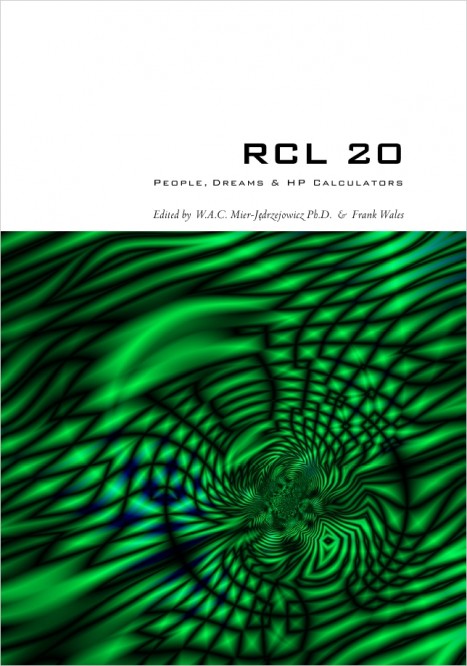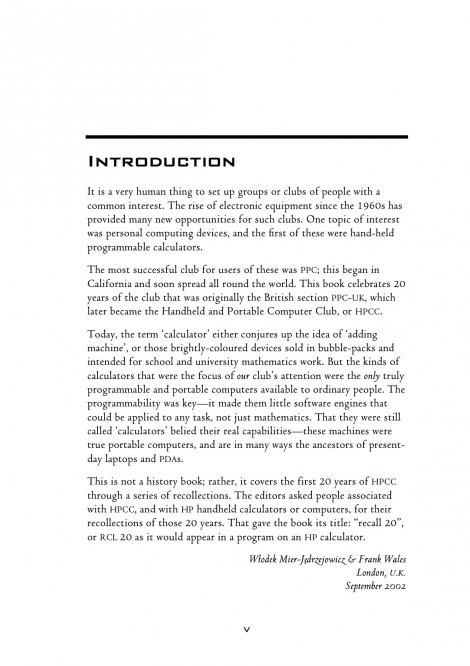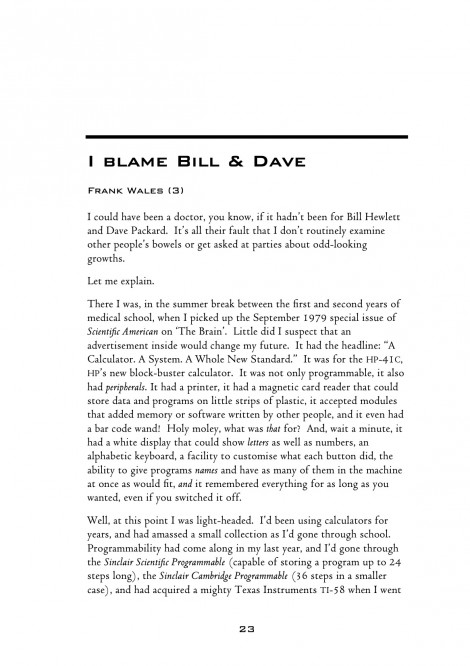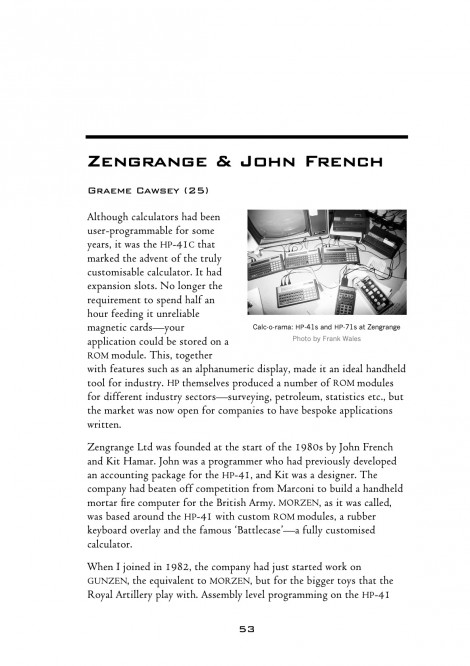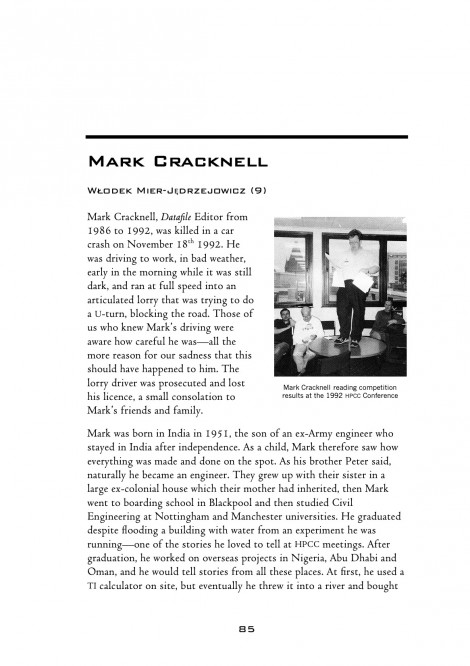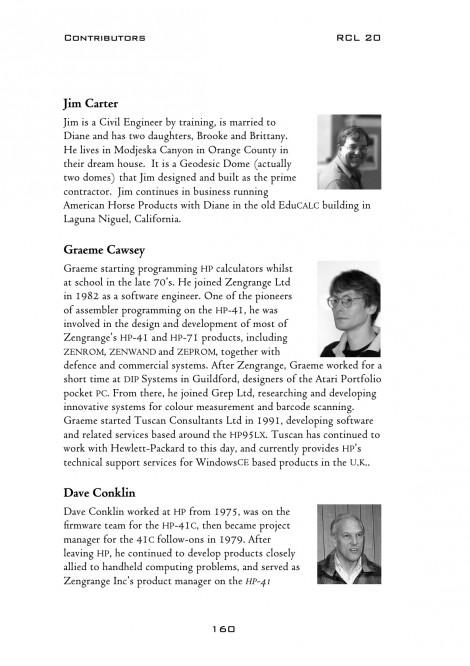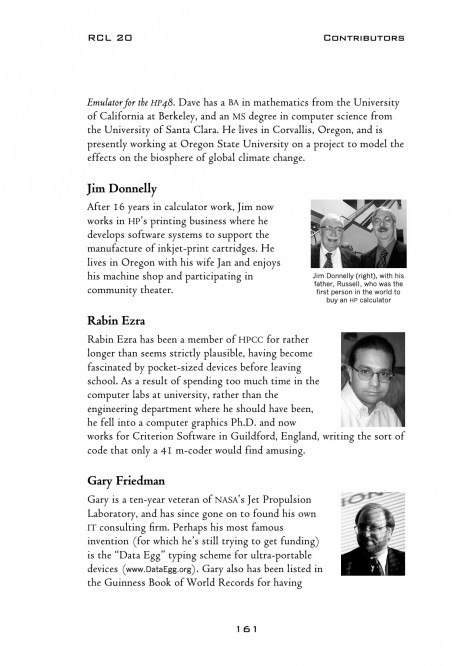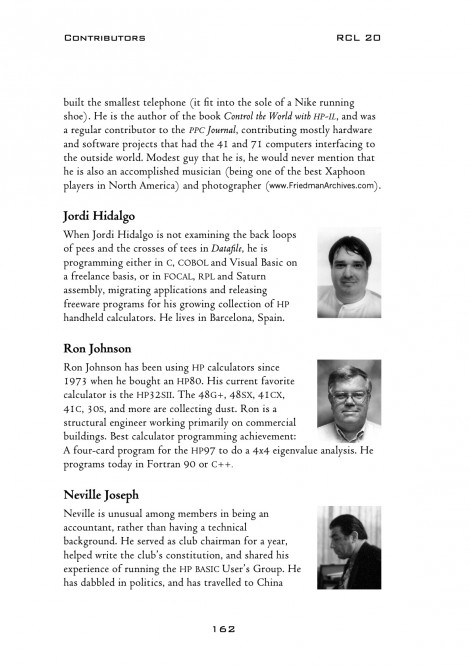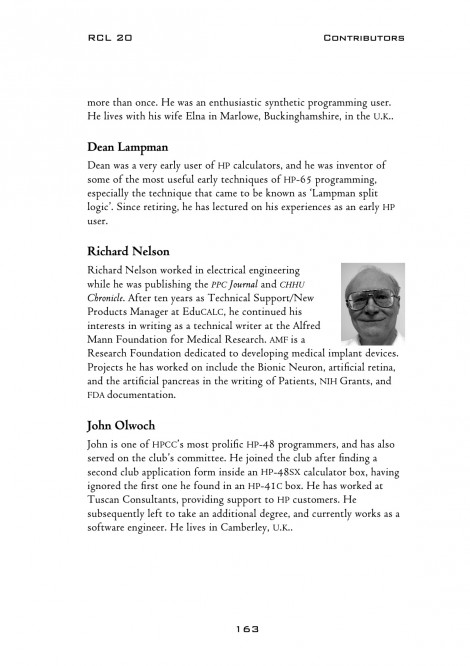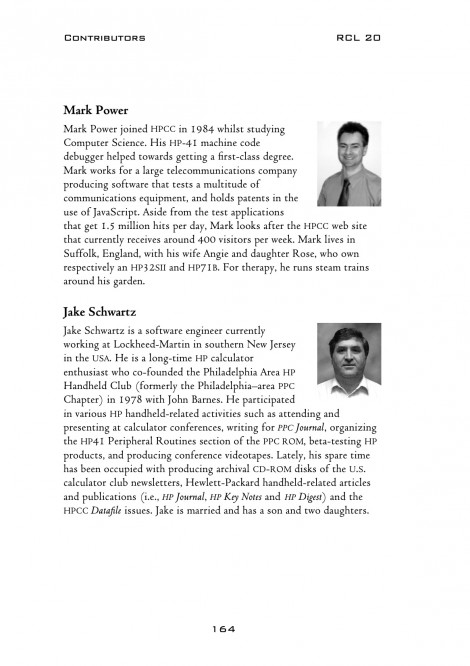RCL 20
| Editors | Wlodek Mier-Jedzrejowicz & Frank Wales |
| ISBN | 0-9510733-3-8 |
| Published | 2002 |
| Format | paperback |
| Pages | 190 |
| Dimensions | 14.8cm x 21cm (A5) |
Postage costs
| UK | £2.70 | 2 working days |
|---|---|---|
| Europe | £5.85 | 3-5 working days |
| USA | £9.20 | 6-7 working days |
| Rest of world | £10.90 | 6-7 working days |
Description
RCL 20: People, Dreams & HP Calculators celebrates 20 years of HPCC, the Handheld and Portable Computer Club (formerly PPC-UK), and was produced in time for the HPCC twentieth anniversary conference in September 2002.
Back cover text
Before the web, before PDAs, before PCs, one company provided a vision of how computers and software could change lives when put into the hands of ordinary people. Hewlett-Packard's amazing series of hand-held calculators and portable computers, begun in 1972, has introduced a generation of technically-inclined people to personal computing power.
As these tiny computers have grown in capability to be depended on in space missions and on battlefields, people around the world have banded together in so-called "user groups". Through these, they've exchanged information, solved each other's problems, and enjoyed learning about (and playing with!) computers. In the process, they've also made friendships, started businesses, and contributed to the computing environment we live in today.
One such user group, the Handheld and Portable Computer Club (HPCC), started in Britain in 1982 as an off-shoot of the huge US-based group PPC, and is still active twenty years later.
This book celebrates the twentieth anniversary of HPCC. Inside:
- we see what the future of portable computers looked like in 1978
- HPCC founders and members write about the club, and remember those members who have passed on
- the founders of HPCC, PPC and other clubs discuss what they have learned by starting and running them
- the engineers of HP's calculators reveal their thoughts on the company and its products
- fans of HP's smallest computers explain what they find so special about them
Introduction
It is a very human thing to set up groups or clubs of people with a common interest. The rise of electronic equipment since the 1960s has provided many new opportunities for such clubs. One topic of interest was personal computing devices, and the first of these were hand-held programmable calculators.
The most successful club for users of these was PPC; this began in California and soon spread all round the world. This book celebrates 20 years of the club that was originally the British section PPC-UK, which later became the Handheld and Portable Computer Club, or HPCC.
Today, the term 'calculator' either conjures up the idea of 'adding machine', or those brightly-coloured devices sold in bubble-packs and intended for school and university mathematics work. But the kinds of calculators that were the focus of our club's attention were the only truly programmable and portable computers available to ordinary people. The programmability was key—it made them little software engines that could be applied to any task, not just mathematics. That they were still called 'calculators' belied their real capabilities—these machines were true portable computers, and are in many ways the ancestors of present-day laptops and PDAs.
This is not a history book; rather, it covers the first 20 years of HPCC through a series of recollections. The editors asked people associated with HPCC, and with HP handheld calculators or computers, for their recollections of those 20 years. That gave the book its title: "recall 20", or RCL 20 as it would appear in a program on an HP calculator.
Wlodek Mier-Jedrzejowicz & Frank Wales
London, U.K.
September 2002
I blame Bill & Dave
by Frank Wales
I could have been a doctor, you know, if it hadn't been for Bill Hewlett and Dave Packard. It's all their fault that I don't routinely examine other people's bowels or get asked at parties about odd-looking growths.
Let me explain.
There I was, in the summer break between the first and second years of medical school, when I picked up the September 1979 special issue of Scientific American on 'The Brain'. Little did I suspect that an advertisement inside would change my future. It had the headline: "A Calculator. A System. A Whole New Standard." It was for the HP-41C, HP's new block-buster calculator. It was not only programmable, it also had peripherals. It had a printer, it had a magnetic card reader that could store data and programs on little strips of plastic, it accepted modules that added memory or software written by other people, and it even had a bar code wand! Holy moley, what was that for? And, wait a minute, it had a white display that could show letters as well as numbers, an alphabetic keyboard, a facility to customise what each button did, the ability to give programs names and have as many of them in the machine at once as would fit, and it remembered everything for as long as you wanted, even if you switched it off.
Well, at this point I was light-headed. I'd been using calculators for years, and had amassed a small collection as I'd gone through school. Programmability had come along in my last year, and I'd gone through the Sinclair Scientific Programmable (capable of storing a program up to 24 steps long), the Sinclair Cambridge Programmable (36 steps in a smaller case), and had acquired a mighty Texas Instruments TI-58 when I went to university, which was sleek, black, angular and could store 480 steps (but unfortunately forgot them all when it was turned off). But seeing the HP-41C ad was like being someone who'd had a couple of bicycles and a scooter, and who was presently driving around in a Ford Escort, only to discover that there was this little company called Mercedes-Benz.
I had been toying with the idea of getting one of the so-called personal computers that had been showing up around this time, but things like the Commodore PET, the TRS-80 and the Apple II all had two problems: they were too expensive, and they were tied to mains power. I really wanted a computer that I could carry around with me, rather than one that stayed at home. I wanted one because I secretly enjoyed programming a lot more than my "official" studies, and I wanted to learn more about software. I was also successfully deluding myself that I could have a day-job in health care, and just do programming in my spare time (of which I would have approximately zero hours per week for the next hundred years). The appearance of the HP-41C effectively put paid to that little scenario, although I didn't realise it right away.
I had to have one, and months of waiting for them to appear at the local calculator shop only heightened my anticipation. It didn't help that, in the interim, I'd become fed up with the short-comings of the TI-58 (losing all the programs and data when switched off, clunky user interface, rattly keyboard) and had sold it and bought an HP-33C, an entry-level little machine. This really sealed my fate, because it let me discover just why HP calculators were considered in a different league from all the other machines on the market:
the build quality was amazing—it felt just right in the hand; the keyboard had a fabulous tactility to it that was almost seductive to use, and the whole thing just seemed like it would last longer than me
its Reverse Polish Notation system, with its four-level stack and last-x was just so obviously better than the alternative "algebraic input" (yeah, right) systems of its competitors—it let you back up, correct errors, change your mind as you worked through a problem, and let you see the answer take shape as you went along, so you could have confidence in it
errors didn't blow away what you were working on—you could clear them and continue from where you had got to before doing the wrong thing, as opposed to the lame, lazy behaviour of other machines where a blinking 'E' meant you had to start again
it had a whole gamut of carefully thought-out functions and operations that clearly provided a cohesive set of capabilities—it didn't have all that bolted-on statistics rubbish, or the collection of disjoint function sets amusingly called "modes", that are the hallmark of badly designed machines—it even had built-in self-tests that you could use to prove it was still working okay!
it looked good too—it was clearly a serious tool for serious work, and even people who didn't ordinarily care about such technology were drawn to look at it, to touch it, to pick it up and to ask about it
Despite being merely a little computational device, it had a physical and a logical design that set it apart from all the other products ostensibly like it on the market. It had clearly been designed and manufactured under the supervision of people who: a) knew what they were doing, and b) actually cared about putting the best possible tool in the hands of the customer.
Given that this entry-level calculator—this mass-produced widget—was of such obviously high quality, what could HP's new top-of-the-line machine be like? I couldn't resist. I had to have one.
Being a poor student, I had to take out an HP loan[1] to buy the HP-41C that I had ordered. It arrived at the end of 1979, and it is perhaps no coincidence that my academic performance went south shortly thereafter. I found myself looking forward to my next laboratory assignment, not because I wanted to learn more about the biochemical or pharmaceutical principle it was meant to be teaching me, but because it gave me the chance to write yet another purposeful program on my HP-41 to solve the problems posed in the experimental notes. My fellow students became interested when they saw that I was able to complete the work faster and more accurately than they could, thanks to the programs I was writing before and during each lab. It wasn't long before it was routine in labs for me to pass my HP-41 around the bench for everyone else in my group to use for their calculations and reporting as well. But this also meant I had to take the time to make sure the program was correct, and that it could be used by people who didn't have a clue about things like RPN.
Without realising it, I had become an end-user application programmer in a vertical market, and was spending more of my time at the back of lectures writing software for the next lab than paying attention to the boring noise coming from the front of the lecture hall. That I found my "real" studies boring is possibly the largest single clue that I had got on the wrong train, academically speaking, but it wasn't until I started meeting real patients in actual hospitals that the penny dropped that I was in the wrong place. Then it was merely a case of breaking my parents' hearts, annoying my tutors and making most of my friends think I was a total idiot by bringing to a conclusion the chain of events that were put into motion when I saw that advert in Scientific American a year before—I stopped attending classes, got kicked out of medical school, then immediately went back and signed up for computing science, and got a real education in the stuff I'd been figuring out in my "spare time."
It was during this second wind of studies that I found out about PPC. This also happened as a result of one of the more subtle qualities of the Hewlett-Packard Company-after-sales support. For calculators! HP published a little magazine called HP Key Notes that printed useful information, tips and other things of value to their calculator customers. The December 1980 issue printed a review of a book by a certain Dr William Wickes called Synthetic Programming on the HP-41C. If that isn't a title designed to pique the interest, I don't know what is. What on earth was synthetic programming[2]? I ordered a copy of this book, which described how to do entirely new and undocumented jiggery-pokery on the very machine that I thought I knew pretty well by this point. It also revealed an amazing amount of information on how the 41 worked internally, none of which I had had access to before.
The book also explained about this group you could join, to learn more and even be a part of the process of discovery: PPC in Santa Ana, California. I joined up, bought all the back issues of the PPC Journal back to the release of the HP-41, and was as happy as a pig in the proverbial. There was so much to learn, and almost all of it was useful, either directly in programs I was writing, or as practical examples for my studies.
In March 1982, David Burch's letter appeared in PPC Journal, inviting people in the U.K. to contact him to help set up a British chapter of PPC—the rest, as they say, is the history that's written down elsewhere in this book. Through what was started as PPC-UK, and what has since become HPCC, I met John French (who ran Zengrange), who subsequently hired me and some other PPC-UK members to develop cool stuff for what today would be called the "HP-41 computing platform" and its successors. Those people had all seen what was great about HP calculators, and had absorbed some of the values of HP as a result. Over the next several years of working with and for HP, we learned a career's worth of lessons on how to design systems, how to treat customers and how to use technology, lessons that still serve us well many years after having left Zengrange for other computing pastures.
Bill Hewlett once said that HP calculators were ambassadors of HP quality, and he was right. However, they also carried the virus of HP values, able to infect susceptible individuals, and lure them into thinking that excellence and high quality are worthwhile and attainable, and worth striving for.
I never had the pleasure of meeting Bill or Dave while they were alive. I always imagined that, if I had, I would have said: "it's your fault I'm not a doctor, and for that I'd like to shake your hand."
Notes
- In fact, the type of loan I took out is called "hire purchase", where you make regular payments, but the item is legally only on hire to you from the loan company until the final payment is made, at which point you have actually purchased it. This type of scheme is generally referred to by its initials: HP. I am not making this up.
Okay, I'll tell you. It's programming the calculator using instructions that the designers didn't anticipate you could enter. They come about by playing tricks on the machine to glue together bits and pieces of instructions in its memory. It will then blithely execute these, on the assumption that they must make sense. This process of synthesising new instructions from existing parts gives "synthetic programming" its name. On the HP-41, synthetic programming had so many benefits that enormous amounts of effort went into making it easier. I'm proud to say that one of my contributions to this art was co-developing ZENROM, which eliminated the distinction between synthetic programming and regular programming.
Editors
Wlodek Mier-Jedrzejowicz, co-editor
- Constitution and name
- Datafile
- Mark Cracknell
- Conferences & meetings
- Gerry Rice
- Half a Beep
Frank Wales, co-editor
- The founding of HPCC (interview with David Burch)
- I blame Bill & Dave
Contributors
David Burch
A letter to PPC Journal
Diana Byrne
Graphing calculator design and development
Jim Carter
A Short History of EduCALC
Graeme Cawsey
Zengrange & John French
Dave Conklin
HP-41 design
Jim Donnelly
My walk along the Hall of Fame
Rabin Ezra
The early years
Gary Friedman
A hardware hacker's perspective
Jordi Hidalgo
Why we need Datafile
Ron Johnson
CHIP chapter recollections
Neville Joseph
Users' clubs
Dean Lampman
The most toys
Richard Nelson
Starting a calculator club
John Olwoch
The end of an era
Mark Power
hpcc.org
Jake Schwartz
Founding the Philadelphia-area PPC Chapter
Jeremy Smith
HP&emdash;There is no sequel
Bill Wickes
A Really Pathetic Name
Raan Young
Portrait of the engineer as a young nerd
Reviews
"Technical people are often not very good storytellers. The chapters of RCL 20 are a pleasant exception. You don't have to be a 'calculator nut' to enjoy them, to feel a sense of shared adventure, to understand the incredible excitement that these machines brought to their owners over the years."
Viktor T. Toth
www.rskey.org/rcl20.htm
"any HP calculator fan will find it entertaining and enlightening"
Warren Furlow
www.hp41.org/History.html
